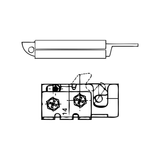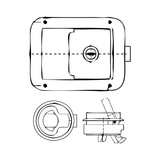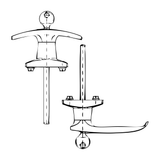
What Locking Solution should you choose? - Your Comprehensive Guide.
What Locking Solution should you choose? - Your Comprehensive Guide.
Choosing the right locking style to suit your project or application can be a stressful and time-consuming affair. If you aren't well versed in the different methods of lock actuation it's easy to get caught in the trap of thinking "surely any lock will be secure enough," but what really is the difference?
Read on below and you will discover more about the sometimes-vast differences in security provided by the different locking solutions available on the market today.
All locks are useful for security and "keeping the honest out" but in reality, not all locks are created equal and unfortunately, those who might want to seek access into whatever it is you are securing, will often know the differences and how to exploit them.
In terms of use, mechanisms, technology, and materials, each lock lends itself to a certain variety of uses that are fit for purpose. From the tried-and-true Padlock, Door Hardware, Automotive Locks and Handles, Switchboard and Enclosure Hardware, Digital Access or even into the real nitty gritty, the Barrels & Cylinders themselves.
This brief yet comprehensive guide will help break down some of the key components and what to look out for when choosing the ideal locking solution for your build and assist in determining the perfect locking solution for your needs.
Locking Types
Padlocks
The trusty Padlock is one of the oldest styles of locking mechanisms used within in human history with some examples dating back to the Roman era, they are composed of a body, shackle or hasp and a locking mechanism.
Padlocks can be a swing away style, slide out of body, circular design or even steel cable. Available at all price points, this style of lock can come in a huge variety of sizes and configurations that use most available locking solutions in different key styles, key combinations and even electronic keying.
For the security rating conscious, padlocks in high-end materials such as hardened and stainless steels are also an option.
Economy Style Barrels
This is the most common locking style on the market and used by most "no-brand" or cheaper handles.
They are also found in a range of other products on the market (such as generic style folding-t's and compression latches etc.) and thus there can be a degree of overlap between similar key codes and product ranges. This means that there is a greater risk of someone having a key that may grant access to your handles.
They also provide minimal security with the locking mechanism being mass produced and easily opened with a screwdriver by those who know how.
Automotive Key Style
These automotive key locking solutions, as the name suggests may use keys and barrels similar in appearance to older model car keys.
These mechanisms are perfectly fine, ensuring a good amount of security and providing a greater range of key codes that can be offered within a particular style of handle.
Euro and Half Euro Profile Cylinder
Pin tumbler locks come in a variety of cylinder designs, and the euro is a particular style profile cylinder. Euro and Half Euro profiles are often used in electrical enclosures, automotive and commercial and residential door hardware. They can be easily replaced allow you the ability customise the compatible keys and increase security.
Some euro locks feature five pins and others six, the inclusion of the additional pins in six-pin locks makes these harder to pick or force, making these a more secure choice.
Generally speaking, a full euro profile will range between 60mm to 120mm, with the locking pawl situated in in the middle. Whereas a half euro is a shorter model of a full euro and are designed for use where key access is only required from one direction and constitute a locking pall on the end, these on average range between 40mm to 50mm in length.
Scandinavian Profile Cylinder
Scandinavian Oval Cylinders use an open profile to allow the keys to be cut easily. They are primarily used throughout Europe and share many operational characteristics with both Half Euro (different shaped profile) & Aussie Oval (larger oval profile) cylinders.
Australian Oval (570) Profile Cylinder
Much like the Scandinavian Oval, The Australian Oval or 570 profile cylinder is oval in appearance. It is larger than its Scandinavian counterpart and if primarily used in commercial and residential door hardware. An excellent solution if you are looking for a high level of security with the ability to organise unique custom keying.
BiLock
BiLock is a high-security key and cylinder system designed and manufactured by Australian Lock Company. It is advertised to be bump-proof, pick-resistant and drill-resistant. The cylinder uses a patented locking system made up of two sidebars, twelve pins, and twelve springs.
PD Cylinder
A PD cylinder is a type of locking cylinder barrel, generally only found in use on commercial and residential internal doors. They are a lower grade security cylinder that is ideal for the purpose of mainly locking off internal rooms, such as offices and bathrooms.
Mortice Locks
Mortice locks have a larger housing than euro cylinders and are threaded, which makes them highly resistant to being forced. Due to their size, they are compatible with a smaller range of doors.
Digital Access and Electronic Locks
Electronic locking operates by means of an electric current to activate either magnets, solenoids, or motors to actuate the locking mechanism. There are two basic styles used, a preventing mechanism or operation mechanism.
The parameters under which the device operates can range from something as simple as using a switch, or can be quite intricate and employ a range of additional security measures such as biometrics or encrypted fine access control systems.
Some systems, like our iLOQ range, offer an extremely versatile range comprising of functionality and maximum security, all without the need for batteries!
SCEC-rated key barrels and Security Ratings
SCEC-rated key barrels are part of the Security Construction and Equipment Committee (SCEC)-approved security products used in Australian Commonwealth departments and agencies. These key barrels ensure the secure storage and management of high-security keys.
SCEC evaluates protective security products and categorizes them into four SEEPL levels based on their relative “security strength” for use in government applications:
- SL4 (High Threat): Offers the highest level of security.
- SL3 (Medium Threat): Provides moderate security.
- SL2 (Low to Medium Threat): Acceptable for lower-threat areas.
- SL1 (Low Threat): Lowest acceptable level of security for government use.
Single and Multi-Point Systems
Single Point Locking
Most locking solutions on the market are typically sold as a single point solution. They are referred to this as there will only be one contact point retaining the doors position.
Multi Point Locking
In some instances, you will find locksets that are designed to be compatible with multi, two-point or three-point locking systems. Instead of having one single main locking point, two locking rods or cables extend off the locking plate or cam and act as a linkage system.
These run the length of the door via a rod guide and can use a rod and/or roller to either sit behind the frame gusset or internally withing the door and slot into the frame itself. You can also possibly utilise a rod slam catch or rotary burst latch.
Latching Methods
Slam Locks and Spring-Loaded Slam Catches

Slam locks and spring-loaded slam catches use an automatic method of latching (without needing the aid of a key or manual operation of a handle) that is used in a wide array of applications and come in a variety of configurations and styles. They allow the operator to open the door manually and not have to worry about the task of closing and locking it if their hands are full. As the door is slammed shut the spring-loaded cam/tongue/catch will either retract back into the housing or turn/twist out of the way as it passes over the striker plate, "springing" back into position as the path of motion becomes unrestricted once more. Some configurations are designed to also operate with the use of locking rods as a primary retaining method.
Compression Locks

Compression locks allow the ability to latch the mechanism and then apply additional compression to help ensure a tighter seal. They come in a range of sizes and configurations including push button, quarter-turn and T handles.
Used largely with camping accessories, vehicle canopies, and some electrical or HVAC enclosures where vibration, dust or water ingress can be a potential concern. You can adjust the amount of pressure to perfectly suit your requirements.
Latch Locks

Latch locks are great as they come in a variety of sizes and configurations including flush finger pulls and paddle handles. They can be added to the inside, outside, or on the surface of doors without affecting existing mechanisms. Mostly found on gates and doors that need to close but not lock, they offer a simple, easy, and functional solution. The mechanism allows doors to be closed and latched to stay shut, without locking.
Folding T Locks and Whale Tails

Most useful for toolboxes, vehicle trays and canopies. Folding T and whale tale handle locks provide a reliable and secure solution as well as offering convenient ease in functionality. The folding mechanism means the handle can fold flush with the dish and hides out of the way, this helps ensure a cleaner design aesthetic.
Panel Locks

If you’ve got a door that needs keyless entry, but you’d still like to be sure is kept shut, panel locks are the perfect solution. Using either pull rings, easy lift paddles or sliding panels, they’re as easy as they are functional. The simple and straightforward design means they can be installed on doors and sit flush with the surface. The handle mechanism is designed in such a way so that the latch retracts, and the door is able to open. To shut a door with a panel mechanism you can simply push the door shut and it will latch closed as they are generally spring loaded.
Swing Handles

Swing handle locks are a key hardware component in many commercial and industrial enclosure and switchboard cabinets. They are commonly used in areas where superior tamper resistance is required and are well suited for use in exposed outdoor applications that support a higher IP (weather and dust resistance) rating. Available in a wide variety of finishes and locking styles to suit every requirement, including high security solutions, they are the switchboard industry standard!
Quarter Turn and Coin/Cam Locks

Used in a range of applications ranging from electrical switchboards through to furniture cabinetry, quarter turn and coin and/or cam locks are typically made up of a key barrel or drive bit insert, escutcheon body and cam, making for a simple and reliable, yet effective locking solution that also offer a wide array for finishes and keying options.
Cam Locks (also referred to as Coin Locks) are L-shaped locking systems (Similar to Quarter-Turn Locks, but generally smaller in size) that are commonly used to secure cabinets, lockers, and other similar enclosures. Selectlok Australia offers an extensive range of Cam (Coin) Locks that are available in different configurations. Get in touch with us if you are looking to buy cam (coin) locks for industrial purposes.
They are also available as wing knobs, tear drop knobs, combination locks and turn handle operations.
T and L Handles

Another "relic" from previous generations, the trusty T and L handle locks are a tried-and-true solution for securing a wide range of applications. They are commonly found on sheds and garage doors, in automotive applications (such as glass and fiberglass doors/tailgates) or on older or residential style electrical enclosures.
They work well with single or multi-point locking, adjustable cams and even emergency internal handles.
Decision Time!
Well, that was easy!
In buying from Selectlok, you're buying from an Australian owned and run business that has been at the forefront of product design and innovation across a range of key infrastructure and manufacturing industries spanning over 45-years.
You're already on the Selectlok website, we have a huge collection of Locking Solutions and complementary products to choose from. So, if you're looking for a long lasting, high-quality, heavy duty security solution, Selectlok is the obvious choice. What are you waiting for?
